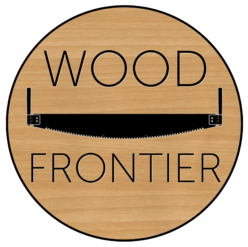I decided to make some better handles for these cheap files. I bought the set for around $7 and expected their lifespan to be limited to the immediate project. However, they proved to be useful and stuck around.
I wanted to keep my mind off of something so a simple project like this was ideal. I started out by removing the plastic handles. They came off easily with a twist of my locking pliers. There are a number of ways to mount and drill small spindle pieces on your lathe. I’ll show you two of them.
The first way is using a scroll chuck. If you don’t have small pen jaws, you can turn a very small tenon that is captured in the center where the woodworm screw usually attaches. You don’t get the benefit of the dovetailed chuck jaws, but it does hold. You have to be sure to keep your knuckles away from the jaws as there is not a lot of clearance. They stick out further than the piece you are working on and if you let them, they will bite you. ouch! The second way doesn’t require a chuck at all. I’ll show you that in just a minute.
To drill out the handle, I first made a small recess in the center to help guide the bit. Using locking pliers, I slowly worked the bit in. It is important to back out the bit to clear out the waste. For this depth wasn’t critical, but when it is a piece of masking tape on the bit lets you know when to stop.
Using the roughing gouge and then my skew chisel, I brought the piece down into roughly a teardrop shape. I like using a skew for spindle pieces when I can. Using a planing cut and rolling out beads will give you fantastic surfaces right off the tool. The sandpaper equivalent to a well-executed planing cut with a sharp skew chisel can easily be 400 grit. The payoff of learning this tool is tremendous, but it can be frightening to the uninitiated. Find a mentor, take a skew skills class, study the tool, practice, and most importantly don’t give up.
I had made three shallow v-cuts with the skew for decoration and used wire burner.
The second way to mount small spindle pieces like this is to turn part of the wood to match the taper on your lathe. The easiest way to match the taper is to make a small taper template jig using 3 pieces of scrap wood. Lay a drive center onto one piece of scrap and sandwich either side with smaller pieces of scrap. Glue these pieces on and you can now turn a piece of wood to match the spindle’s taper without having to constantly take it off and re-mount it or mess around with calipers.
Using a wooden mallet, tap the taper in and you are all set. Be mindful of any cuts that push directly out from the headstock, but if the fit is nice and snug you will have few problems. I like this method because you don’t have to worry about clearance from chuck jaws and it is very quick to set up once you have your taper template made. The only real downside is the wood inside the taper isn’t usable for this project, so it might not be ideal for exotic and expensive woods. But it is a rather elegant solution.
I used some fine grit sandpaper just to make sure things were cleaned up where I had parted the handles off of the lathe. After wiping off the dust I simply used a coat of mineral oil. These are working tools, so an elaborate finish is not necessary. The oil gives this alder wood a nice feel and emphasizes the grain patterns.
After letting the oil soak in I put the files into the handles. They have a decent pressure fit, but if they wiggle to much during use I’ll think about using CA glue or epoxy to secure them.
Once you start making tool handles on a lathe, it is easy to start looking for other things that “need” their handles replaced. Files, chisels, awls, screwdrivers, lathe tools, power tool levers and knobs, are all begging for the upgrade. Serving spoons, whisks, and other kitchen implements are also great candidates.
Thanks for watching wood frontier. I’ve got a new woodworking video each month so hit that subscribe button to make sure you see it. Also feel free to let me know in the comments if there are any specific builds you want to see or questions you have.
Keep on Turning!

